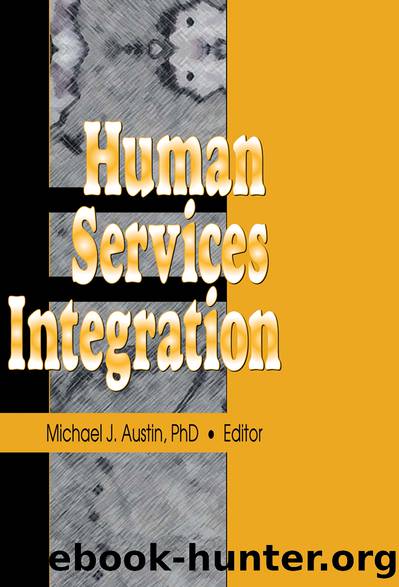Human Services Integration by Austin Michael J.;

Author:Austin, Michael J.; [Austin, Michael J.]
Language: eng
Format: epub
Publisher: Taylor & Francis Group
Published: 2022-08-15T00:00:00+00:00
Evaluating Interagency Collaboration
The literature suggests that evaluation of interagency collaboration is a challenging endeavor, fraught with many difficulties. Guthrie and Guthrie (1991) note that very often people do not think of evaluation of programs or collaborative efforts until they are well underway and it is too late to gather the necessary data. They stated that in this type of evaluation evaluators ask both summative and formative questions and go beyond traditional measures of program effectiveness. Kagan (1991) maintained that there is mounting literature that demonstrates the challenges of evaluating collaboration. She further stated that work has emerged that suggests collaborations are effective catalysts for change and much can be learned from their processes. Kagan identified a number of questions that should be assessed in this type of evaluation. For example: What differences does collaboration make? How do we know when we have achieved success? What have we really learned from pioneering efforts? Guthrie and Guthrie (1991) identified questions such as: How effective was the collaboration? Was communication improved? Have bureaucratic barriers been overcome? How can interagency collaboration be improved?
Flynn and Harbin (1987) discussed design issues that must be considered when conducting evaluations. They suggested consideration be given to the purpose and the audience; the framework that is selected, making sure that it is in conjunction with the paradigm; how the results will be used (summative vs. formative); research strategies (qualitative vs. quantitative); how the evaluation will be funded; and who should conduct the evaluation.
Kagan (1991) indicated that to assess the efficacy of collaboration, three conditions must be met: the goals of the endeavor must be clear, the collaboration must be implemented, and the standards of measurements must be precise and replicable. Many challenges exist to this type of evaluation including questions on how to define the goals of collaboration. Current research suggests two broad goals of collaborationâone relates to producing direct changes in service delivery systems; the other relates to fostering or creating systems change. Some collaborations may attempt both of these goals simultaneously.
Additional dimensions that make evaluations difficult arise because collaboration has multiple process and outcome dimensions, thus complicating the challenges of defining precise success criteria. For example, does success mean that all or part of the goals have been achieved? Or does overall success mean partial success in all areas or full success in a few areas? Kagan (1991) concluded that rather than seek overall indices of success or dubbing efforts as exemplary models, one may do well to consider partial conditions of success within specific circumstances. In addition, she indicated that evaluation is difficult because implementation is never fully completed; therefore, it is hard to attribute outcomes to a certain intervention if it cannot be determined whether the intervention has actually been implemented.
The second factor defined by Kagan (1991) is equally problematic. In order to attribute outcomes to an intervention, it is necessary to ascertain whether the intervention has been implemented. As collaborations are designed to be flexible and to meet changing needs, their implementation is never complete.
Download
This site does not store any files on its server. We only index and link to content provided by other sites. Please contact the content providers to delete copyright contents if any and email us, we'll remove relevant links or contents immediately.
Application of a Novel Technique for Clinical Evaluation of Nitric Oxide-Induced Free Radical Reactions in ICU Patients by Unknown(696)
Rosenâs Emergency Medicine Concepts and Clinical Practice by Ron Walls; Robert Hockberger; Marianne Gausche-Hill; Timothy B. Erickson; Susan R. Wilcox(572)
Oxidative damage to surfactant protein D in pulmonary diseases by Vitality Starosta1 & Matthias Griese1†(408)
Social Science Perspectives on Global Public Health by Vincent La Placa & Julia Morgan(373)
Constructing Canine Consent; Conceptualising and Adopting a Consent-focused Relationship with Dogs by ERIN JONES(330)
Organic Chemistry: An Acid - Base Approach by MICHAEL SMITH(299)
ADVANCED EMERGENCY CARE AND TRANSPORTATION OF THE SICK AND INJURED by Unknown(271)
Saunders Nursing Drug Handbook 2024 - E-Book by Unknown(263)
Socio-Life Science and the COVID-19 Outbreak : Public Health and Public Policy by Makoto Yano; Fumihiko Matsuda; Anavaj Sakuntabhai; Shigeru Hirota(246)
Diagnostic and Statistical Manual of Mental Disorders, Fifth Edition, Text Revision (DSM-5-TR(tm)) by Unknown(246)
Davis's Comprehensive Manual of Laboratory and Diagnostic Tests with Nursing Implications by Unknown(245)
Human Microanatomy; Cell Tissue and Organ Histology with Celebrity Medical Histories by Stephen A. Stricker(243)
Berne and Levy Physiology E-Book by Unknown(234)
Replacing the Dead by Mie Nakachi;(229)
Handbook of Skin Disease Management by Jiyad Zainab;Flohr Carsten; & Carsten Flohr(228)
Access to Medicines and Vaccines in the South : Coherence of Rules and Policies Applied by the European Union Commission by Stephen Kingah(225)
The Pocket Guide to Sensorimotor Psychotherapy in Context (Norton Series on Interpersonal Neurobiology) by Pat Ogden(218)
Deep Learning and Medical Applications by Unknown(217)
Advances and Technical Standards in Neurosurgery by Unknown(214)
